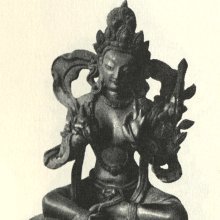Sadhumati, Sādhumatī: 6 definitions
Introduction:
Sadhumati means something in Buddhism, Pali, Hinduism, Sanskrit. If you want to know the exact meaning, history, etymology or English translation of this term then check out the descriptions on this page. Add your comment or reference to a book if you want to contribute to this summary article.
Images (photo gallery)
In Buddhism
Mahayana (major branch of Buddhism)
Source: Wisdom Library: Maha Prajnaparamita SastraSādhumatī (साधुमती) or Sādhumatībhūmi refers to the “bhūmi of good prajñā” and represents one of the ten Bodhisattva grounds (bodhisattabhūmi), according to the Daśabhūmikasūtra, or Daśabhūmīśvara, as mentioned in the 2nd century Mahāprajñāpāramitāśāstra chapter 52.—Sādhumatī-bhūmi is also known as “legs paḥi blo gros, chan ken or chan houei”. The Bodhisattva-mahāsattva in the ninth ground (sādhumatī-bhūmi) must completetly fulfill twelve dharmas.
What are these twelve?
- In universes infinite in number, the Bodhisattva takes hold of the class of beings capable of being converted (vineyabhāga).
- All obtain according their wishes.
- The knowledge of the languages spoken by the devas, nāgas, yakṣas and gandharvas.
- The talent of eloquence.
- The excellence of the descent into the womb.
- The excellence of the birth.
- The excellence of the family.
- The excellence of the clan.
- Excellence of the entourage.
- Excellence of departure.
- The excellence of the splendor of the tree of enlightenment.
- Excellence in the complete accomplishment of all the qualities.
These, O Subhūti, are the twelve dharmas which the Bodhisattva-mahāsattva in the ninth ground must fulfill completely.

Mahayana (महायान, mahāyāna) is a major branch of Buddhism focusing on the path of a Bodhisattva (spiritual aspirants/ enlightened beings). Extant literature is vast and primarely composed in the Sanskrit language. There are many sūtras of which some of the earliest are the various Prajñāpāramitā sūtras.
Tibetan Buddhism (Vajrayana or tantric Buddhism)
Source: archive.org: The Indian Buddhist IconographySādhumatī (साधुमती) or Sādhumatībhūmi refers to one of twelve Bhūmi Goddesses, as commonly depicted in Buddhist Iconography, and mentioned in the 11th-century Niṣpannayogāvalī of Mahāpaṇḍita Abhayākara.—Her Colour is white; her Symbol is a sword on lotus; she has two arms.
Sādhumatī is described in the Niṣpannayogāvalī (dharmadhātuvāgīśvara-maṇḍala) as follows:—
“Sādhumatī is white in colour and holds in her left hand the sword on a night lotus”.
[These twelve bhūmis [viz., Sādhumatī] are two-armed and hold in the right hand the vajra and in the left their own weapons or signs.]

Tibetan Buddhism includes schools such as Nyingma, Kadampa, Kagyu and Gelug. Their primary canon of literature is divided in two broad categories: The Kangyur, which consists of Buddha’s words, and the Tengyur, which includes commentaries from various sources. Esotericism and tantra techniques (vajrayāna) are collected indepently.
General definition (in Buddhism)
Source: Wisdom Library: Dharma-samgrahaSādhumatī (साधुमती, “really intelligent”) or Sādhumatībhūmi refers to the ninth of the “ten stages of the Bodhisattva” (bhūmi) as defined in the Dharma-saṃgraha (section 64). The Dharma-samgraha (Dharmasangraha) is an extensive glossary of Buddhist technical terms in Sanskrit (e.g., sādhumatī). The work is attributed to Nagarjuna who lived around the 2nd century A.D. Arciṣmatī is also included in the “thirteen stages of the Bodhisattva” (trayodaśa-bhūmi).
Languages of India and abroad
Sanskrit dictionary
Source: Cologne Digital Sanskrit Dictionaries: Edgerton Buddhist Hybrid Sanskrit DictionarySādhumatī (साधुमती).—(1) name of the ninth bodhisattva-bhūmi: Mahāvyutpatti 894; Dharmasaṃgraha 64; Daśabhūmikasūtra 5.10 etc.; Bodhisattvabhūmi 354.7; Laṅkāvatāra-sūtra 15.5, etc.; (2) name of a goddess: Mahāvyutpatti 4295.
Source: Cologne Digital Sanskrit Dictionaries: Monier-Williams Sanskrit-English Dictionary1) Sādhumatī (साधुमती):—[=sādhu-matī] [from sādhu-mat > sādhu > sādh] f. one of the ten grades of a Bodhi-sattva, [Catalogue(s)]
2) [v.s. ...] Name of a Tantra deity, [Buddhist literature]
[Sanskrit to German]
Sanskrit, also spelled संस्कृतम् (saṃskṛtam), is an ancient language of India commonly seen as the grandmother of the Indo-European language family (even English!). Closely allied with Prakrit and Pali, Sanskrit is more exhaustive in both grammar and terms and has the most extensive collection of literature in the world, greatly surpassing its sister-languages Greek and Latin.
See also (Relevant definitions)
Starts with: Sadhumatibhumi.
Full-text: Sadhumatibhumi, Bhumi, Rutajnana, Ruta, Dvadashabhumi, Bodhisattabhumi, Bodhisattvabhumi, Vikurvana, Grihapati, Grihapatiratna.
Relevant text
Search found 5 books and stories containing Sadhumati, Sādhumatī, Sadhu-mati, Sādhu-matī; (plurals include: Sadhumatis, Sādhumatīs, matis, matīs). You can also click to the full overview containing English textual excerpts. Below are direct links for the most relevant articles:
Maha Prajnaparamita Sastra (by Gelongma Karma Migme Chödrön)
Bhūmi 9: the ground of good wisdom (sādhumatī) < [Chapter XX - (2nd series): Setting out on the Mahāyāna]
Chapter XX - (2nd series): Setting out on the Mahāyāna
Note (2). The ten Bodhisattva grounds or abodes < [Chapter XX - (2nd series): Setting out on the Mahāyāna]
A comparative study between Buddhism and Nyaya (by Roberta Pamio)
4.2. The Two Truths < [Chapter 2 - The Four Buddhist Schools of Philosophy]
Lankavatara Sutra (by Daisetz Teitaro Suzuki)
Bodhisattvacharyavatara (by Andreas Kretschmar)
Introduction By Dzogchen Khenpo Chöga < [Introduction Text]
A Dictionary Of Chinese Buddhist Terms (by William Edward Soothill)
